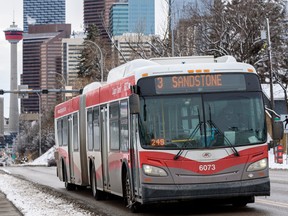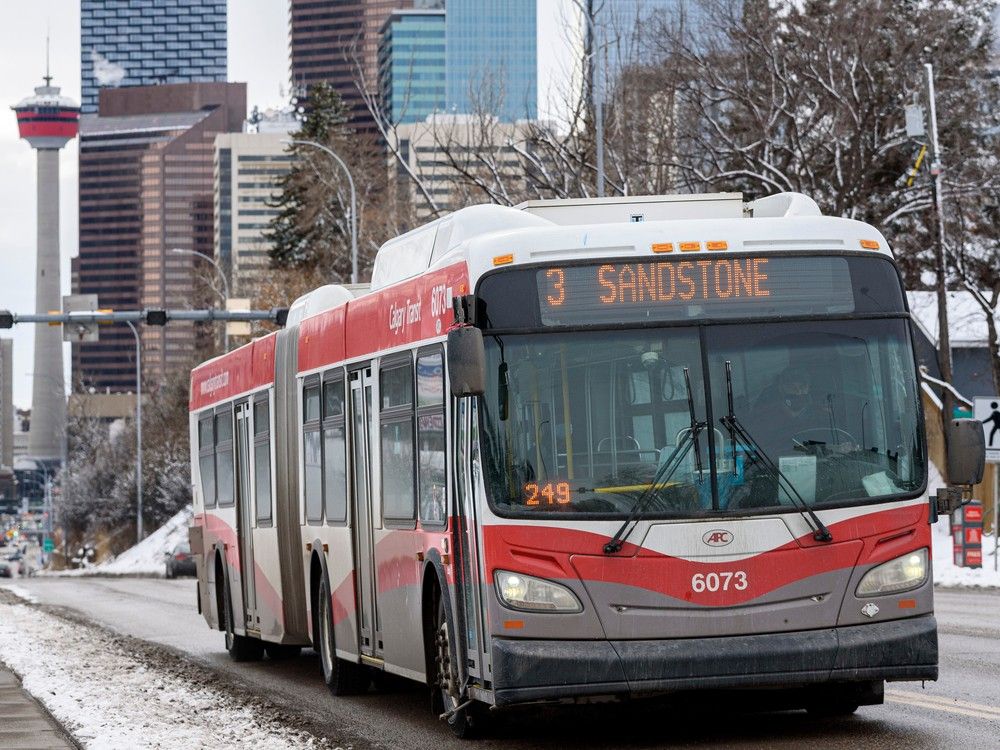
Article content
An early vote on one aspect of Calgary’s Route Ahead transportation plan has some councilors divided on the document’s priorities.
Advertisement 2
Article content
After the double whammy of an economic downturn followed by the COVID-19 pandemic, transport is looking to shift its priorities as it rebuilds with a focus on more frequent journeys on its primary transport network – the main lines that form the backbone of the city’s transport system.
Article content
The Council’s infrastructure and planning committee heard on Thursday how the new target is to see buses and trains running every 10 minutes or better on the core network from 6am to 9pm.
To do that, transit says coverage may be reduced in some areas, meaning some people may have to walk farther to catch a bus. However, once they arrive at their stop, they should expect more frequent service.
One transit advocate who spoke at the public hearing suggested that 15 hours a day of more frequent service might not be enough.
Advertisement 3
Article content
“It might work for a sleepy city on the prairies, but not a city rushing to two million people,” said Jeff Binks, president of LRT on the Green, “In the summer, the sun is still up. People still enjoying patios downtown. A person on the evening shift and Foothills Industrial still isn’t done.”
Binks said 6 a.m. to 11 p.m. would be a better window for regular transit service.
Shovel. Jasmine Mian said the city is constantly hearing from riders about the problem with frequency.
“That’s the number one thing that comes up over and over and over again, through every type of engagement that we do, is that the buses and the LRT don’t come often enough for me to ride regularly,” Mian said.
However, some councilors with newer communities in their ward raised concerns about the frequency-for-coverage trade-off.
Advertisement 4
Article content
Ward 13 gr. Dan McLean said he has met with the administration about the changes to routes in his ward and he is concerned that they are being cut too much.
“I’m a little disappointed because they’ve cut off some of the routes, especially to the deep south where communities are growing,” he said. Lots of new Calgarians – thousands – are coming in. And there always seems to be more focus on transit for the city center.”
He said he’s seen examples of senior centers losing their stops, which would mean those residents would have to walk several blocks to catch a bus. He said this is done in the name of speed, but it doesn’t make the new routes that much faster,
Shovel. Jennifer Wyness asked the administration how transit would help people move in their wards, rather than just bringing them downtown.
Advertisement 5
Article content
“So you do a 10-minute (frequency), but essentially your goal is to move everyone downtown within 10 minutes. But many people want to move in and around their communities just as quickly to get to the grocery store.”
Administration responded that the primary transport network does include routes across the town and strives to connect all activity centers around the city.
-

Council to consider transport project priorities in the run-up to Route Voort report
-

Calgary Transit plans to expand on-demand service to more communities
-

Calgary Transit says it needs a year to reach pre-pandemic staffing levels
In a 6-5 split, the committee narrowly approved the changes, which will now go to the council for a final vote. Councilors McLean, Wyness, Sonya Sharp, Andre Chabot and Peter Demong voted against the changes.
Advertisement 6
Article content
Sharp said she could not support the new direction as presented because she wondered what the trade-offs were when it came to frequency over coverage.
“If there was any kind of example that business affairs administration could have provided us with, that would have been better,” she said.
Sharp said she’s heard examples where people would have to walk 20 minutes to get to a bus stop, and that doesn’t take into account people with mobility issues or the fact that Calgary is a winter city.
Like Wyness, she was also concerned that it was too focused on downtown and downtown, to the detriment of newer communities.
“I look at places like Valley Ridge that don’t have regular bus service, and we have a high concentration of college students trying to get to school,” Sharp said. “So, you know, they have to get to the train station, and there’s no bus service right now.”
Sharp said she might get behind the changes if the administration can address some of her concerns when the final Route Ahead report comes before council in the spring.
brthomas@postmedia.com
Twitter: @brodie_thomas

